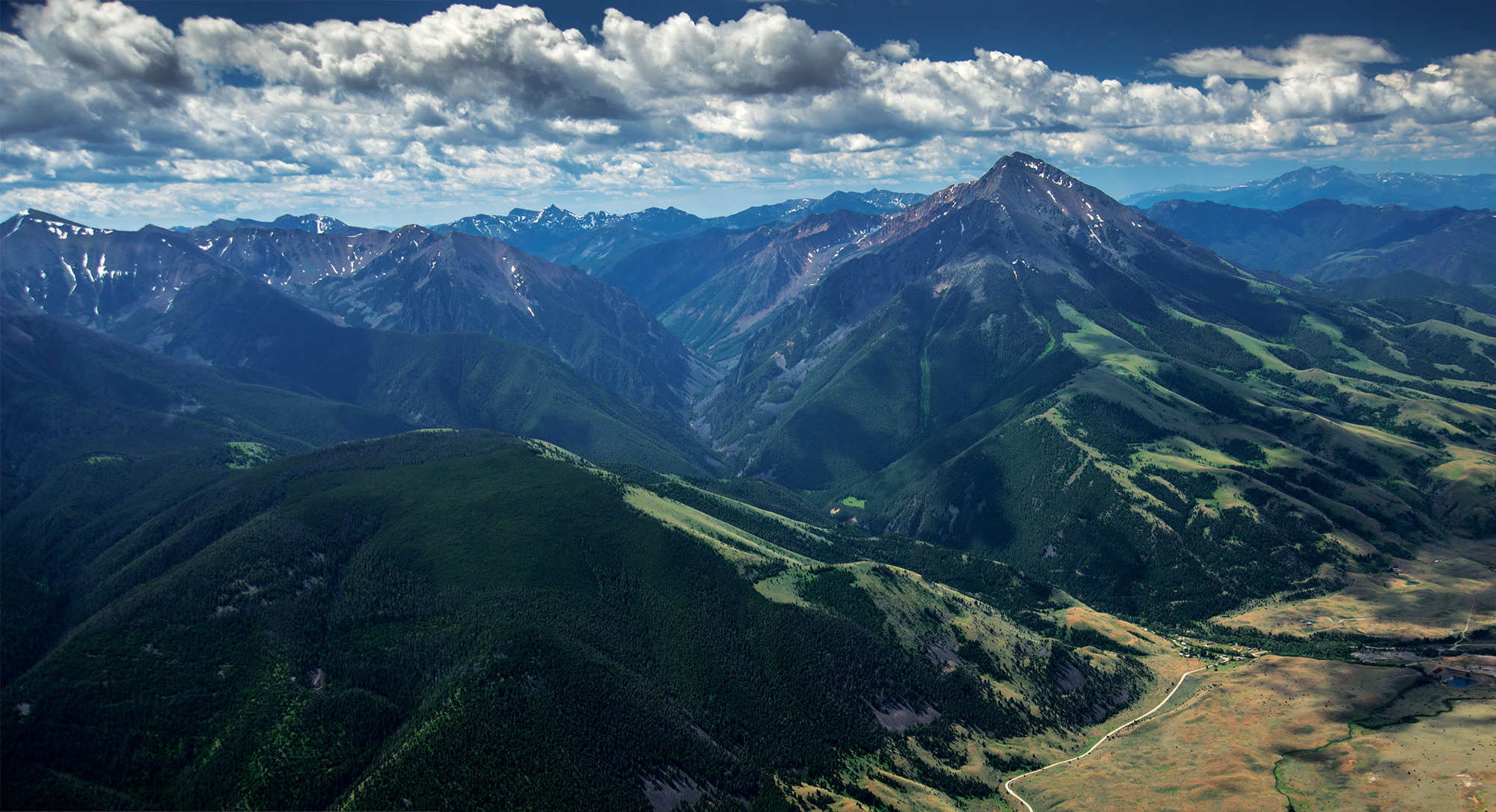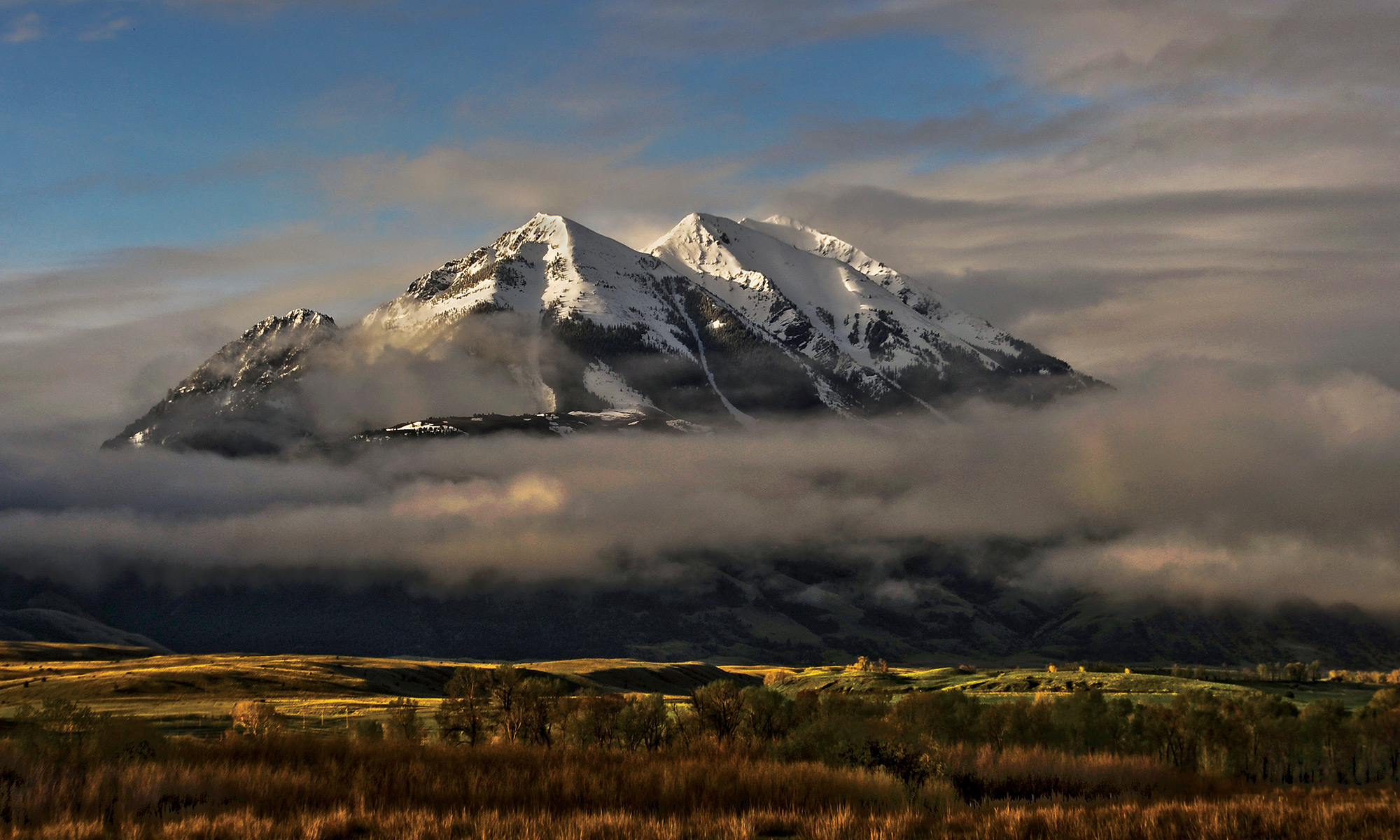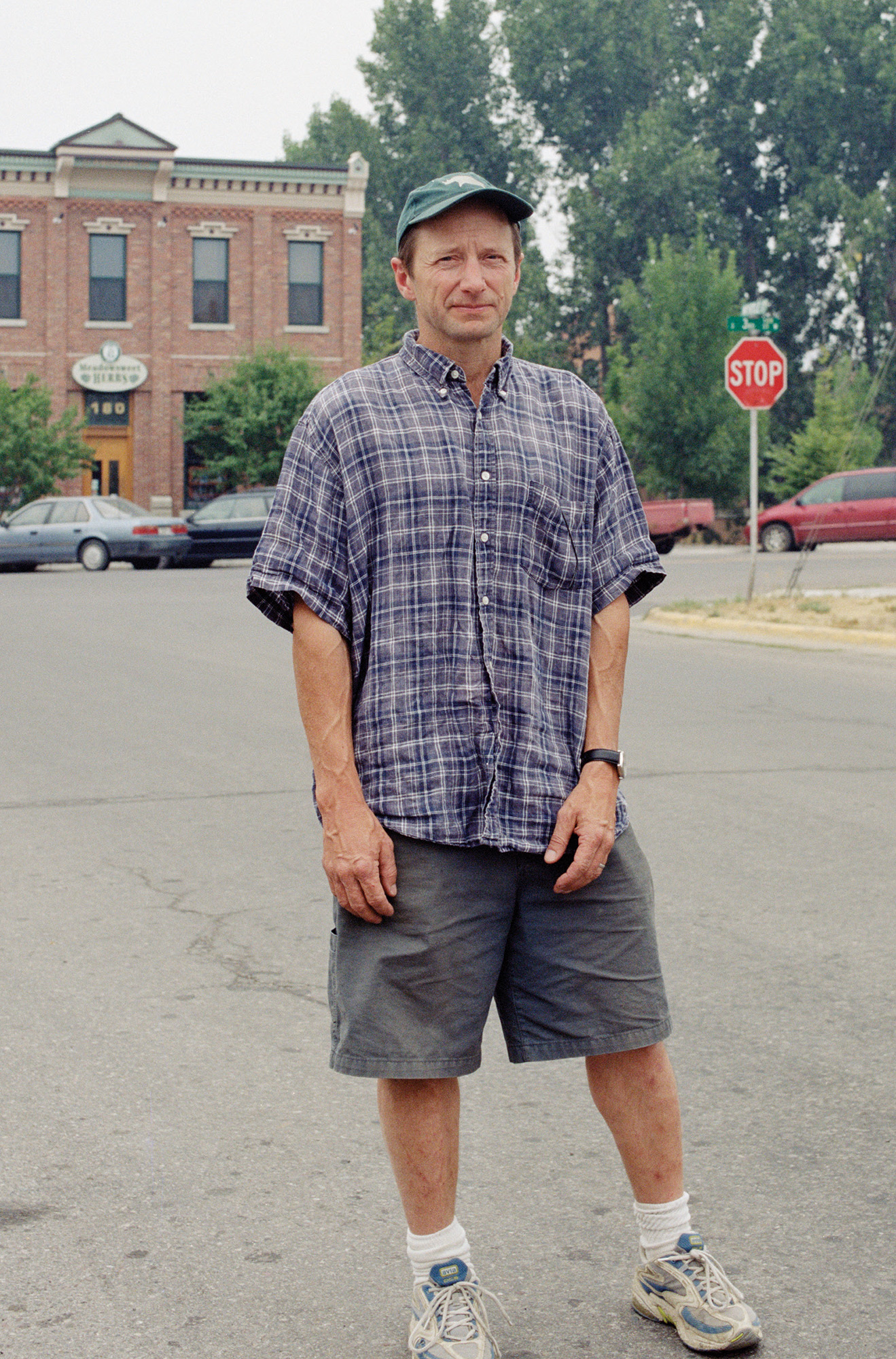
09 Jun A Story of Turning Back
I WONDER WHAT EMIGRANT PEAK looks like from the top. It’s the dominant feature in Paradise Valley, just outside the historic Chico Hot Springs and just north of Yellowstone National Park. I’m living part of the year a few hundred yards from the mountain’s base.
One way to get there: You drive until you can’t go any farther. The rocky road up Emigrant Canyon — named for the first wave of miners who came crawling and creeping up this slot in the earth, down which gushes a torrent, a cataract, so narrow that in places a gifted athlete, a single human, could vault from one side to the other without getting wet.
Others, just as resolute, might advance by wading up the creek, slipping on the jagged stones. Tiny crystals glitter here and there like grains of salt drying on a creature’s skin, or like scales, or feathers, flexing just-so in the sunlight. Life, briefly.
I park, and walk. Gutshot spatters of oil — some fresh, others ancient — spackle the cobbles. The road is packed hard by centuries of greed and desperation, but still is loose underfoot — the shards, the puzzle pieces, will not yet peaceably assemble — and the rubble is treacherous. My ankles tingle, knowing how easy it would be to fold or roll one on this infinitude of loose stone.
When you hear the word treachery, you think that by virtue of your being aware, you can avoid it: that simple forewarning and awareness is all that’s required. But this is not the nature of treachery. Treachery is patient. It waits for you to become fatigued. It waits. In this way it is as patient as geology. It endures, just beneath the surface.
Lucky Minerals is the latest to file claims up here. (For God’s sake, blokes, at least have some creativity in the naming.) In the old days there were men with mules and pans, bent humpbacked over the torrent, deafened by the incessant roar of the thing they never dreamed might become rare or even go away. Later, here, they dug and scratched, then gouged and blasted. Giant bulldozers clattered and groaned, carving through the seemingly-impossible rock. Once a road is in, in this country, it’s all over. It will not be reclaimed. It will not be grown over. It becomes geology. It becomes a way.
They came then with giant hoses and vats of acid. There were no rules, and they destroyed much that was beautiful. Then there was one rule, perhaps the most obscene subsidy our country has ever given to industry or the so-called myth of free enterprise and “business.” It was the business of wrecking, the business of the 1872 Mining Act, still buried within a dusty quill-and-ink ledger somewhere far in the basement of the Library of Congress. It puts forth a sweet gig for the Canadians — for anyone — where we give up ownership of our mountains to anyone who wants to climb up into the highest points and then stack a little cairn of rocks, plant a little flag. We killed or imprisoned all our native people, shoved them out of these mountains, only to then give them away to any nation who wanted to come in and plant a silly little flag. It’s an old rule. There is much in the foundation of our country that is no longer sturdy, if ever it was.
There is much that began wrong, and has not gotten any more right with time. There is much that is great — take the park itself, just a few miles south of here (which was also created in 1872) — but there is also looseness underfoot, and here in Emigrant Canyon, the ghosts, to paraphrase Faulkner, are not even ghosts. The hunger, the meaningless yearning, the hollowness for the colorful mineral, is so profound that it seems you could sift flecks and flakes of it — not the gold, but the wanting, and the unhappiness — from the wild little river with a pan; could distill it, in reverse alchemy, into jewelry or whatnot. Bracelet of sorrow, necklace of regret, amulet of waste and devastation.
Two-thirds of the way up the mountain, there’s a new little claim, a scrap of tin, like the scissor-snipped side of a soft drink can, the soft metal scratched with a few crude letters, Lucky Minerals, Rosie #22. (Elsewhere, one assumes a Rosie #21, a Rosie #26 — maybe half a hundred little Rosie-piles.) There’s not even a cairn here, as was done in the old days, no neat stacking of rocks, just some nasty-ass new pink flagging fluttering in the high dry winds aloft, and an empty bottle of pain reliever stobbed onto a branch. Trash. Trash. Now they own it, and are presumably waiting, in the time-honored tradition of American kabuki-dance that our government enacts with corporations, to be bought out, paid off, given hundreds of millions of dollars from the federal treasury in exchange for not gouging the gates of Yellowstone further to get to the last and deepest thinleaf sheaf or laminae of gold — the last capillary — that their maps show or prophesy might lie still farther beneath all that has already been sluiced out.
It’s like paying someone not to write a novel, or not to embark upon a pro football career. It’s damned unlikely that it could be done anyway. But the map proposes value, and Lucky, and Rosie, whoever she is, by sticking her aspirin bottle in the crotch of a tree nearly 10,000 feet above the floor of the old sea (whose trace minerals precipitated out, here and there, falling in slow motion glitter to the bottom of the sea, or circulating deeper within the gurgling fire of the mountains that were about to burst out and be formed), owns this northern gateway to Yellowstone now. Not bad for a day’s hike and a penny’s worth of plastic flagging. And now Lucky is likely just waiting for Congress to pay them to go away. Holding the mountains hostage.
As if it is still 1872. As if steam vessels are still plying the Atlantic, journeying over from England, as if the Industrial Revolution has not yet begun, as if the Sioux and Cheyenne are still defending this country against the depredation of Custer and the U.S. Army; as if Tolstoy still sits at his desk, writing instead of living a life, as if Einstein is not yet born, is not yet brooding on the equations whose paths will lead to an understanding of how to destroy matter in ways never before imagined. As if Eastern tourists have not even begun to take the long train ride West, braving the wilds of Yellowstone to stuff their dirty laundry down into the pie-hole of Old Faithful, whooping and otherwise exulting when it disgorges long minutes later, steam cleaned, if a bit sulfurous. All gone now, but when the act was written, they were not here yet. They have come and gone, and still the rule remains. You may have our mountains for a song. You may have them for free.
Do I pay attention to the artificial, invisible lines of domain? I do not. I travel the shape of the mountain, in violation I suppose, of the 1872 act, written by the same session of Congress that successfully prevented women from voting, and which sought to keep men with non-white skin from voting. The mountain is several hundred million years young, and I walk right up it, picking my way through talus and the shade of droughty overstocked fir, the forest so hot it seems to be panting.
Every step remains treacherous, but I’m distracted. I can’t help but look up at the amazing mountains that flank both sides of the canyon. The sweet scent of cottonwoods along Emigrant Creek. Sheer cliffs, single slabs of vertical rock: no way up here, and I walk on, watching, looking for a fissure, a chute. After a few miles there’s a gate with a Private Property sign on it, even though the map shows the land belongs to us, to the U.S. government. Public. I’ve reached Lucky’s lode.
Others have been here. Long ago, a pipe was sunk into the ground, up which water wells mysteriously, spreading across the old stone road — a green algae slick of a puddle surrounds the pipe’s bubbling mouth, the water is clear, cool, gurgling, tempting, and most assuredly arsenic-laden. I sip from my water bottle, and, to avoid breaching the gate, begin to climb straight up the slope, into the tangled forest, gripping the slender trunks of Doug fir hand over hand.
To my left — in the appropriated territory, or expropriated — the mountain looks pretty lunar: the scene of a mountain massacre. Rubble and rock roads winding and writhing up into a broad basin, the zippered contours of excavations, rumpled hills bulldozer-shoved, terraced troughs dug. It would be nice to take the easier route but the Canadians say they own it now and have posted the hell out of it, telling us we can no longer travel there.
Up through the spindly cliff-clinging trees, then picking a route, straight up. A spine is gained, a fin, which I hope will lead to a ridgeline pass, from which I can then approach the summit of Emigrant.
Altitude is gained: a trade, half a peanut butter sandwich for 500 more feet, or a thousand; a sip of water, clean water, for another 500. After a while I’m high enough to see other scratchings, little human rodent-caves where the miners of a hundred years ago scratched and clawed and sniffed at the rocks like wild beasts in search of salt. It may be assumed they lived quick lives that you might be tempted to say had no real meaning; and you might be right. They could have been mindless machines, not people, searching for any old mindless thing; what did it matter if it had economic worth? They were just scratching at the skin of things, then they left.
Does it matter? Of course it does. Does passion matter? Yes! Isn’t obsession one of the peculiar and alluring aspects of being human? Certainly. So why is a passion for digging a claim far up in the lonely, beautiful mountains — and in so doing, using a loophole to wrest control of the ownership of that mountain from the public treasury (350 million of us; one man or woman, one vote) — to one’s own brief self — a bad passion? One man or woman, one mountain, now. A mountain in every pot.
Perhaps the differences between good and bad passions, good and bad obsessions, is this: There is that which destroys, and that which builds up or preserves. Perhaps that is all.
There is also, I suppose, the in-between: the line or path of no-passion, or not-caring. And so the 1872 Mining Act remains, never erased. And our lives are so short and we go on, clinging to the earth for a little while until we fall off, and the torrents and debris, the arsenic and the dust, keep washing down the creek, out to the Yellowstone River, and into time.
What a scam. The higher I go, the crosser I get. A mountain is no longer wild when there’s a mine on it. A mine kills a mountain. A day of my life has been taken. I chose to climb a wild mountain, but am encountering Rosie’s 22nd spoor, Rosie’s immortal trash pile. I want my mountain back.
And what of the gold that has been leach-poisoned out of this canyon, and from this mountain, already? Where did it go, and how is the world, or even just our one nation, better for its leaving? At what party was the gold leaf necklace admired; on what beautiful lady, insecure, wanting even more beauty, more youth, when already, now and here, is everything; when the body, bare and alive, young and strong, is so much more than enough?
Essentially this mountain has become a two-bit tattoo parlor, selling the promise of something it can neither sustain nor even deliver.
The higher I go, the more brittle the cliffs become: Down lower, there was the steep scree of time-fractured talus; but up higher, the cliffs, rotten with their provenance — ancient sediments lightly lithified, thrust upward and made brittle under pressure — come off in my hand, grip by grip. Boulders tumble down the chutes, clatter and cartwheel sharp-edged, releasing from their broken interiors the acrid scent of rock dust that has not been smelled by any living organism in hundreds of millions of years: dust and air as if from the whirl of a djinn.
These new edges of the cliff are needle-sharp, fang-sharp, and pierce my bare hands; as I ascend, I leave crimson little hieroglyphics on the rocks. Again and again a handhold pulls loose, hurtles down and past my feet, back toward where I started from; as if it is I, and not the miners and their machines, who are dissembling the mountain. As if I am taking it apart stone by stone.
Though I cannot see the top, I can tell I’m getting near the summit by my relative elevation, relative views of the other side of the canyon. And yet: The cliffs are becoming more sheer.
The backside is hard country to traverse. There are 100- and 200-foot spires all around, like those on the churches of the ages, striving upward as if trying to express beauty farther skyward: a church from so long ago.
The higher one gets, the more there is to lose. Here and there are avalanche chutes, clefts and fissures barely as wide as my body, chimneys which, though going straight up, do have handholds and footholds. There is a way up; there is a way, as is almost always the case, to keep going forward.
But is it responsible? I have a family to support, and financial obligations. What if I fall and hit my head? I’m climbing solo, without a helmet. Sure, I can go higher, but what if I can’t find the same route down, and on the return find myself instead cliffed out, at the edge of a precipice down which there is no safe passage?
And for what?
I make the wise decision and, despite being so near the top, turn around and descend. I’ll come back another day and pick another route.
And on my descent, I find the soft rock. It’s just to the east, in the mined-over little basin. Of course they claimed the softer, more passable country. Of course they did.
After a while, it appears that I am walking on their land. After a while, it appears that I have crossed some imaginary line, am on a bladed, winding stony road, switchbacking down, down off the mountain, passing more old cairns. Am I on Canadian soil now, I wonder, does Canada own these stones, every one of them? Many of them are orange and red, others gold, others glow a luminous blue, and still others, black … Quite a few are sulfur-yellow.
Would our country be different if we’d named our first park — the one of which we are most proud, and the one which is most visited, not just by our countrymen and countrywomen, but by all nations — something different? Would we be the same country if we’d named it Bluestone National Park, or Redstone?
No, I don’t think so. It’s not the same.
Two simple words. Yellow, and stone.
- Overlooking Paradise Valley, Emigrant Peak rises to 10,915 feet. Photo by Erik Petersen
- Author Rick Bass has written nearly 30 books of environmental essays, novels, and short fiction. Photo by Jean-Luc Bertini






No Comments